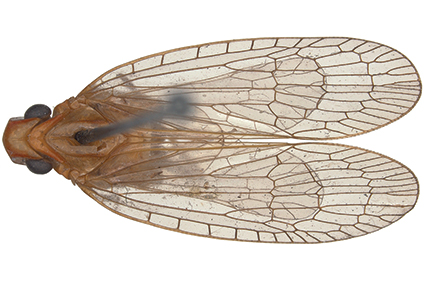Abstract
A new genus and species of the tropiduchid planthopper of the tribe Tropiduchini is described as Bitara augusta gen. et sp. nov. from Madang Province, Papua New Guinea. It is the 18th species of Tropiduchini and the 9th genus known east of the Wallace line. It is another taxon with characteristic asymmetric genitalia within this tribe.
References
Acurio, A.E., Rhebergen, F.T., Paulus, S., Courtier-Orgogozo, V. & Lang, M. (2019) Repeated evolution of asymmetric genitalia and right-sided mating behavior in the Drosophila nannoptera species group. BMC Evolutionary Biology, 19 (109), 1–14. https://doi.org/10.1186/s12862-019-1434-z
Ali, J.R. & Heaney, L.R. (2021) Wallace’s line, Wallacea, and associated divides and areas: history of a tortuous tangle of ideas and labels. Biological Reviews, 96, 922–942. https://doi.org/10.1111/brv.12683
Beron, P. (2015) The Arachnogeography and the “lines” (of Wallace, Lydekker, Weber). Historia naturalis bulgarica, 22, 5–30.
Bourgoin, T. (1988) A new interpretation of the homologies of the Hemiptera male genitalia, illustrated by the Tettigometridae (Hemiptera, Fulgoromorpha). In: Vidano, C. & Arzone, A. (Eds.), 6th Auchenorrhyncha Meeting, Turin, Italy, 7–11 September 1987. Consiglio Nazionale delle Ricerche-Special Project IPRA, Turin, pp. 113–120.
Bourgoin, T. (1993) Female genitalia in Hemiptera Fulgoromorpha morphological and phylogenetic data. Annales de la Société entomologique de France, 29 (3), 225–244.
Bourgoin, T. (2021) FLOW (Fulgoromorpha Lists on The Web): a world knowledge base dedicated to Fulgoromorpha. Version 8. Updated 17 July 2021. Available from: http://hemiptera-databases.org/flow/ (accessed 6 October 2021)
Bourgoin, T. & Huang, J. (1990) Morphologie comparée des genitalia mâles des Trypetimorphini et remarques phylogénétiques (Hemiptera: Fulgoromorpha: Tropiduchidae). Annales de la Société entomologique de France, Nouvelle Série, 26 (4), 555–564.
Bourgoin, T., Wang, R.-R., Asche, M., Hoch, H., Soulier-Perkins, A., Stroiński, A., Yap, S. & Szwedo, J. (2015) From micropterism to hyperpterism: recognition strategy and standardized homology-driven terminology of the forewing venation patterns in planthoppers (Hemiptera: Fulgoromorpha). Zoomorphology, 134, 63–77. https://doi.org/10.1007/s00435-014-0243-6
Cámara-Leret, R., Raes, N., Roehrdanz, P., De Fretes, Y., Heatubun, C. D., Roeble, L., Schuiteman, A., van Welzen, P. C. & Hannah, L. (2019) Climate change threatens New Guinea’s biocultural heritage. Science Advances, 5 (11), eaaz1455, 1–8. https://doi.org/10.1126/sciadv.aaz1455
Carayon, J. (1969) Emploi du noir chlorazol en anatomie microscopique des insectes. Annales de la Société entomologique de France, Nouvelle Série, 5, 179–193.
Eberle, J., Walbaum, W., Warnock, R.C.M., Fabrizi, S. & Ahrens, D. (2015) Asymmetry in genitalia does not increase the rate of their evolution. Molecular Phylogenetics and Evolution, 93, 180–187. https://doi.org/10.1016/j.ympev.2015.08.005
Hosken, D.J. & Stockley, P., (2004) Sexual selection and genital evolution. Trends in Ecology and Evolution, 19 (2), 87–93.
https://doi.org/10.1016/j.tree.2003.11.012
Huber, B.A. (2010) Mating positions and the evolution of asymmetric insect genitalia. Genetica, 138 (1), 19–25. https://doi.org/10.1007/s10709-008-9339-6
Huber, B.A., Sinclair, B.J. & Schmitt, M. (2007) The evolution of asymmetric genitalia in spiders and insects. Biological Review, 82 (4), 647–698. https://doi.org/10.1111/j.1469-185X.2007.00029.x
Huey, R.B., Hertz, P.E. & Sinervo, B. (2003) Behavioral drive versus behavioral inertia in evolution: a null model approach. The American Naturalist, 161, 357–366. https://doi.org/10.1086/346135
Huxley, T.H. (1868) On the classification and distribution of the Alectoromorphae and Heteromorphae. Proceedings of the Zoological Society of London, 1868, 294–319.
Larsén, O. (1938) Untersuchungen über den Geschlechtsapparat der aquatilen Wanzen. Opuscula Entomologica, Supplement, 1, 1–388.
Simmons, L.W. (2014) Sexual selection and genital evolution. Austral Entomology, 53 (1), 1–17. https://doi.org/10.1111/aen.12053
Simmons, L.W., House, C.M., Hunt, J. & García-González, F. (2009) Evolutionary response to sexual selection in male genital morphology. Current Biology, 19 (17), 1442–1446. https://doi.org/10.1016/j.cub.2009.06.056
Stroiński, A. (2020) Hagneia kallea gen. and sp. nov. (Hemiptera: Fulgoromorpha: Ricaniidae) from North Vietnam. Zootaxa, 4861 (2), 241–256. https://doi.org/10.11646/zootaxa.4861.2.5
Wallace, A.R. (1860) On the zoological geography of the Malay archipelago. Journal of the Proceedings of the Linnean Society of London. Zoology, 4 (16), 172–184. https://doi.org/10.1111/j.1096-3642.1860.tb00090.x
Wallace, A.R. (1863) On the physical geography of the Malay archipelago. The Journal of the Royal Geographical Society of London, 33, 217–234. https://doi.org/10.2307/1798448
Wang, R.R., Li, X.L., Szwedo, J., Stroiński, A., Liang, A.P. & Bourgoin, T. (2017) Testing Tropiduchini Stål 1866 (Hemiptera: Tropiduchidae) monophyly, a young inter-tropical taxon of mainly insular species: taxonomy, distribution patterns and phylogeny, with the description of a new genus from Papua New Guinea. Systematic Entomology, 42 (2), 359–378. https://doi.org/10.1111/syen.12219
White, A.E., Day, K.K., Stephens, M. & Price, T.D. (2020) Dispersal syndromes drive the formation of biogeographical regions, illustrated by the case of Wallace’s Line. Global Ecology and Biogeography, 30, 685–696. https://doi.org/10.1111/geb.13250


